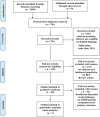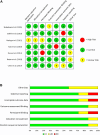Phytotherapy for Attention Deficit Hyperactivity Disorder (ADHD): A Systematic Review and Meta-analysis
- PMID: 35592415
- PMCID: PMC9110892
- DOI: 10.3389/fphar.2022.827411
Phytotherapy for Attention Deficit Hyperactivity Disorder (ADHD): A Systematic Review and Meta-analysis
Erratum in
-
Corrigendum: Phytotherapy for attention deficit hyperactivity disorder (ADHD): a systematic review and meta-analysis.Front Pharmacol. 2024 Mar 14;15:1365806. doi: 10.3389/fphar.2024.1365806. eCollection 2024. Front Pharmacol. 2024. PMID: 38549676 Free PMC article.
Abstract
Attention deficit hyperactivity disorder (ADHD) is commonly a neurodevelopmental behavioural disorder in children and adolescents. Mainly characterized by symptoms like lack of attention, hyperactivity, and impulsiveness, it can impact the overall mental development of the one affected. Several factors, both genetic and non-genetic, can be responsible for this disorder. Although several traditional treatment methods involve medication and other counselling techniques, they also come with different side effects. Hence, the choice is now shifting to alternative treatment techniques. Herbal treatments are considered one of the most popular complementary and alternative medicine (CAM) administered. However, issues related to the safety and efficacy of herbal remedies for the treatment of ADHD need to be investigated further. This study aims to find out the recent advancement in evidence-based use of herbal remedies for ADHD by a comprehensive and systematic review that depicts the results of the published works on herbal therapy for the disorder. The electronic databases and the references retrieved from the included studies present related randomized controlled trials (RCTs) and open-label studies. Seven RCTs involving children and adolescents diagnosed with ADHD met the inclusion criteria. There is a fair indication of the efficacy and safety of Melissa officinalis L., Bacopa monnieri (L.) Wettst., Matricaria chamomilla L., and Valeriana officinalis L. from the studies evaluated in this systematic review for the treatment of various symptoms of ADHD. Limited evidence was found for Ginkgo biloba L. and pine bark extract. However, various other preparations from other plants did not show significant efficacy. There is inadequate proof to strongly support and recommend the administration of herbal medicines for ADHD, but more research is needed in the relevant field to popularize the alternative treatment approach.
Keywords: Melissa officinalis L.; Valeriana officinalis L; attention deficit hyperactivity disorder (ADHD); complementary alternative medicine (CAM); herbal treatments; phytotherapy.
Copyright © 2022 Dutta, Anand, Mitra, Ghorai, Jha, Shaikh, Shekhawat, Pandey, Proćków and Dey.
Conflict of interest statement
Author UA was employed by the company CytoGene Research & Development LLP. The remaining authors declare that the research was conducted in the absence of any commercial or financial relationships that could be construed as a potential conflict of interest. The authors apologize for these errors and state that this does not change the scientific conclusions of the article in any way. The original article has been updated.
Figures






References
-
- Abdul Manap A. S., Vijayabalan S., Madhavan P., Chia Y. Y., Arya A., Wong E. H., et al. (2019). Bacopa Monnieri, a Neuroprotective lead in Alzheimer Disease: a Review on its Properties, Mechanisms of Action, and Preclinical and Clinical Studies. Drug Target. Insights 13, 1177392819866412. 10.1177/1177392819866412 - DOI - PMC - PubMed
-
- Afşin E. K., Erdem R., Yılmaz C., Deniz E. E., Kavalcı C., Özdemir A., et al. (2017). The Effect of Pycnogenol® on Spatial Learning and Memory in Rats with Experimental Closed Head Injury. Haseki Tip Bulteni 55 (2), 101. 10.4274/haseki.3446 - DOI
-
- Anand U., Nandy S., Mundhra A., Das N., Pandey D. K., Dey A. (2020). A Review on Antimicrobial Botanicals, Phytochemicals and Natural Resistance Modifying Agents from Apocynaceae Family: Possible Therapeutic Approaches against Multidrug Resistance in Pathogenic Microorganisms. Drug Resist. Updat 51, 100695. 10.1016/j.drup.2020.100695 - DOI - PubMed
Publication types
LinkOut - more resources
Full Text Sources
Miscellaneous

